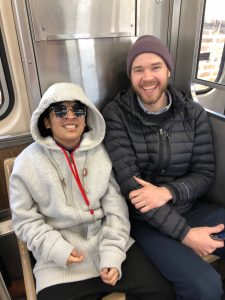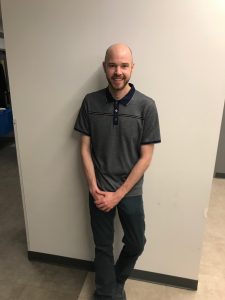JJ’s List recently sat down for an informative Q&A with Kyle, the Travel Trainer for the Chicago Public Schools (CPS).
Q. What is the CPS’ Transportation/Travel Training Program? And what is your role?
A. The Chicago Public School’s (CPS) Travel Training program is designed to teach students with disabilities how to travel to and from school on public transportation. In Chicago, this means riding the Chicago Transit Authority (CTA). The goal of the training is for students to stop taking the yellow school bus and begin taking the CTA independently while enrolled in CPS. My role is a 1:1 trainer known as a Community Integration Specialist. I also take students on college/jobsite tours, connect them with adult agencies, and help them get a State ID or Ride Free Card.
Q. What is purpose of travel training program?
A. The main goal of the program is for students to be able to independently transport themselves between home and school on the CTA. The long term goal is the transfer of these skills, and the confidence the comes with being independent, to other areas of their lives and help them be successful after high school.
Q. Do you teach students to ride the “L” and the bus? What about Metra?
A. We train students on whichever mode of public transportation their route calls for. Some of our students have to take a bus and the “L” to get to school. We have trained students to ride the Metra, but it’s rare for city kids. The Ventra cards we provide the student when they have completed the training do not work on Metra trains, so we try to find an alternate route if that’s the case.
Q. What is the benefit to students from participating in the travel training program?
A. There are numerous benefits that come with students completing the program and subsequently traveling independently. The ability to self-travel opens up many new opportunities for students with disabilities, such as after school activities, getting to a job, visiting a college, etc. For most students, it also improves their self-confidence and informs the way they approach other new things that may appear to be scary overwhelming.
Q. How long does a “typical” training last?
A. The training can last anywhere from 1 day to 13 days, depending on how familiar the student is with the CTA and traveling in the community. Typically, it takes about a week for a student to complete the training.
Q. What is involved in teaching students to ride fixed-route transportation?
A.
1. The first step of the training is meeting with the student, going over the student’s route and covering a few basic travel-related basics, such as
- understanding signs
- using a Ventra card
- following directions
- pedestrian skills
- safe vs unsafe locations
- community awareness
2. Second is the 1:1 training in the community. I like to start the student’s training during the school day, when the CTA is less busy and there are fewer things to distract the student. Initially I model the student and put few demands on them. But as the student becomes more comfortable, I pull back on instruction. Eventually I will sit in a separate spot on the bus or train and give almost no instruction. This forces the student to rely on their own abilities to complete their route.
3. Once the student is comfortable with their route, I will begin to meet them before and after school to train them during the actual time they will be traveling.
4. The final step of the training process is having the student complete their route on their own while I “shadow” them in my car. This allows the student to complete their route independently but also have a safety net in case something would happen.
An example of the process is when I recently trained Quincy, a Lincoln Park High School student. During the final days of training we reviewed the steps she would need to take to get off the bus at her stop: identify her stop, pull the cord, and prepare to exit when the bus stopped. The first day Quincy would identify her stop and then look to me to confirm that she should pull the cord. The next day when she looked to me for confirmation I pretended I did not see her. She hesitated for a bit and then pulled the cord, but it was too late and she missed her stop. She looked a bit nervous, but she got off at the next stop and navigated the walking route back to her house without any assistance from me.
This was a great learning moment for Quincy. She realized I wasn’t always going to be there to help her and she experienced the consequence of not pulling the cord on time. The next day she pulled the cord without looking to me and was ready to exit the bus when it reached her stop.
Q. How is travel training success defined?
A. When it comes to travel training, success is defined per student. Some students have never crossed a street on their own, so simply crossing a street independently is a huge success. Others are familiar with the CTA and traveling in the community, so their success would be defined by them independently traveling between their home and school.
Q. What are some of the obstacles you face as a Travel Trainer? How do you overcome these obstacles?
A. The main obstacle we face is definitely parent resistance, and rightfully so. Parents often want their child to participate in the program, but also want them to stay on the school bus once they have completed the training. We only train students whose parents commit to their child traveling independently once/if they successfully complete the program. We remind parents that after high school there is no yellow bus and of the numerous benefits that come with the ability to self-travel. It’s also helpful to highlight success stories of students who have completed the program in the past.
Q. What do you get out of your job as a Travel Trainer?
A. I find my job to be extremely rewarding. I get to equip young people with a skill that will benefit them for years to come. And I get to see the positive results of my work frequently.
The other day I ran into a former student on the CTA as he was on his way home from his job at Marshalls. When I had first worked with this student he was a senior, he did not travel anywhere on his own, and he had few post-secondary plans. Fast forward two years and he’s independently taking two buses to and from his jobsite. There is nothing better than seeing a student generalize the skill of independent travel and then utilize it to better themselves. That being said, something as simple as a student pulling the cord or slowing down as they approach an alley can absolutely make my day.
Thank you for your time Kyle!






No Comments
No comments yet.